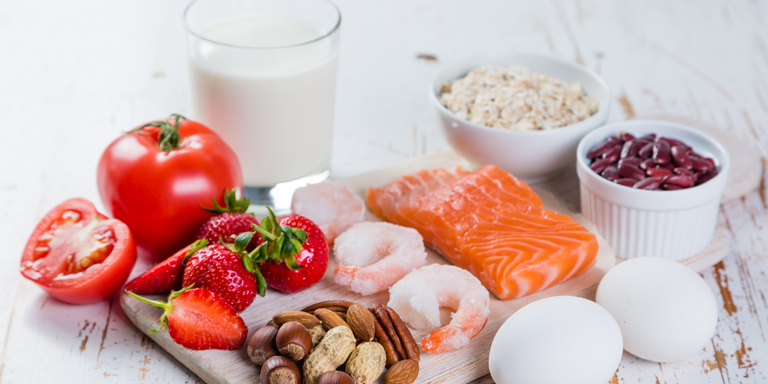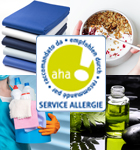Food allergy
Tiny amounts of the food in question are often enough to trigger an allergic reaction.

Table of contents:
In surveys, 30% of the Swiss population claim to be allergic to foods. However, the proven level is only 2–6%. Infants most commonly develop allergies to food but are often able to tolerate them as they get older.
Triggers
Adults are most commonly allergic to hazelnuts, celery, apples, walnuts and kiwi fruit. Especially severe reactions occur with peanuts, seafood and kernels and sesame seed. Children typically have a reaction to cow’s milk, hen’s eggs, peanuts and other nuts.
Symptoms
Common and harmless reactions become noticeable in and around the mouth. These include itching in the lips and throat, a furry feeling in the mouth and palate, and swelling of the lips and tongue and of the lining of the cheeks and throat immediately after consumption. These symptoms are known under the umbrella term, oral allergy syndrome, and often occur with food due to a cross-reaction. Other possible and sometimes severe reactions are: vomiting, stomach or abdominal cramps, diarrhoea, skin reactions, such as eczema and urticaria, asthma attacks, a general feeling of weakness / asthenia, a drop in blood pressure, palpitations and up to and including life-threatening anaphylactic shock.
Diagnosis
Self-monitoring – ideally recorded in a symptom diary – and the results of skin and blood tests are the essential basis for the diagnosis of a food allergy. To confirm the diagnosis and to determine the tolerance level, provocation (or challenge) tests may also be required. Allergy tests can be carried out in babies over the age of 6 months.
Treatment
Strict abstinence is important, i.e. avoiding the allergy-causing food completely. It is also essential to watch for concealed sources in bakery products, sausage, spice blends and semi-cooked and ready foods. If there is a risk of an anaphylactic reaction, it is essential to strictly avoid even the tiniest amounts (traces / contaminants).
In Switzerland, 14 ingredients (see below) that may cause an allergy or other adverse reactions must be clearly labelled and highlighted on the packaging (e.g. in bold type, italics or in capital letters). Unintentional mixtures / combinations must also be mentioned at the end of the list as follows: “may contain …” or “may contain traces of …”. Sales staff in shops selling food (e.g. bakeries, butcher’s etc) and in restaurants, takeaway kiosks etc must also provide information. By law, information supplied verbally by a professional is adequate.
14 allergens:
- grains containing gluten*
- milk*
- eggs*
- fish*
- crustaceans*
- soybean*
- hard-shelled fruit (nuts), i.e. almonds, hazelnuts, cashew nuts, pecan nuts, Brazil nuts, pistachios, macadamia nuts, Queensland nuts*
- sesame seed*
- celery*
- mustard*
- peanuts*
- sulphur dioxide and sulphites in concentrations above 10 mg / kg or 10 mg / L
- lupins
- molluscs
* and any extracted products
Anyone who has already suffered a severe allergic reaction should always carry an emergency medical ID card and an emergency kit. If a new, severe allergic reaction occurs, an emergency doctor or a hospital should be consulted.
Specific immunotherapy with food allergens is not yet available. There are on-going studies attempting to develop oral tolerance in those with food allergies. There has been some initial success, but no treatment can yet be offered to sufferers in clinical practice.
Tips and tricks
- Write the allergy-causing foods on a “visiting card” and hand to restaurant staff when ordering.
- Before holidays, have these cards translated into the local language and take them with you.
- When invited round to friends and family, either tell the hosts exactly about your allergy or offer to take something allergen-free with you.
- Check lists of ingredients of familiar foods before buying. The recipes can be changed at any time. If you are not sure, the manufacturers or wholesalers will be glad to provide information. Their contact details can be found on the packaging.
Facts and figures
- Approx. 2–6% of the Swiss population suffers from a food allergy
- In infants, onset of a food allergy can be the first sign of an atopic predisposition. Sometimes atopic eczema also occurs and later the children often develop hay fever or asthma.
- Approx. 70% of those allergic to tree pollen have crossreactions to certain foods
- Crossreactions between birch pollen and raw stone and pip fruit are common, but can often occur between mites and seafood as well as latex and exotic fruits.
Editors: aha! Swiss Allergy Centre in co-operation with the Scientific Advisory Board.




